THE BATTLES OF LA NAVAL DE MANILA
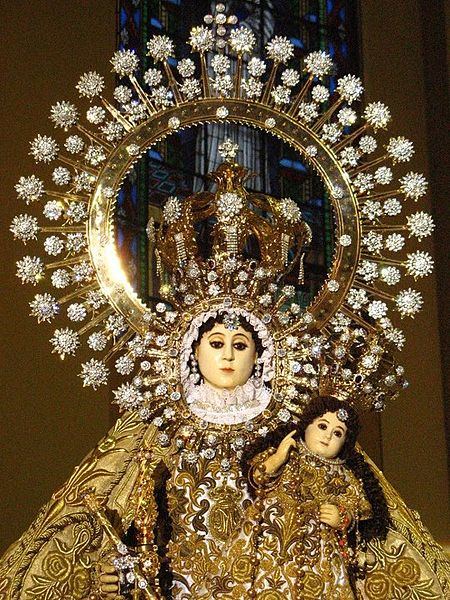
Our Lady of the Most Holy Rosary of La Naval de Manila in Sto. Domingo Church, Quezon City, Philippines. Photo by Interaksyon
Our Lady of the Most Holy Rosary Saves the Philippines from the Invading Dutch Fleet
Inside the Dominican church of Santo Domingo in Quezon City sits in celestial splendor and glory one of the most venerated and beloved image of the Most Holy Virgin in the Philippines. Among an impressive array of twenty-eight canonically crowned statues of the Mother of God in this Catholic nation in the Far East, Our Lady of the Rosary of La Naval de Manila, also known as La Gran Señora de Filipinas and Nuestra Señora del Santisimo Rosario, stands out preeminently in terms of grandeur and beauty. It holds the most singular distinction as the first Marian image to be officially and solemnly crowned as such in the country and Asia (1907).[1]
ORIGIN
One can trace the statue’s origin (circa 1593) to the auspices of a Spanish governor-general of the island nation, Luis Perez Dasmariñas (1593-1596) who commissioned its creation (under the supervision of Captain Hernando de los Ríos Coronel) to honor his deceased father and to serve as a memento to his regime. He entrusted the statue in the hands of Dominican friars who enshrined it in a simple primitive chapel made of cogon grass and nipa palm within the walled city ofIntramuros of Old Manila.
Utilizing hardwood for the torso and elephant ivory for the face and hands, a pagan Chinese artisan, who according to pious tradition converted later to Catholicism through Our Lady’s intercession, skillfully carved and fashioned its unique and indigenous Oriental features that stood out when the white ivory took on a shade of brown through the patina of time.
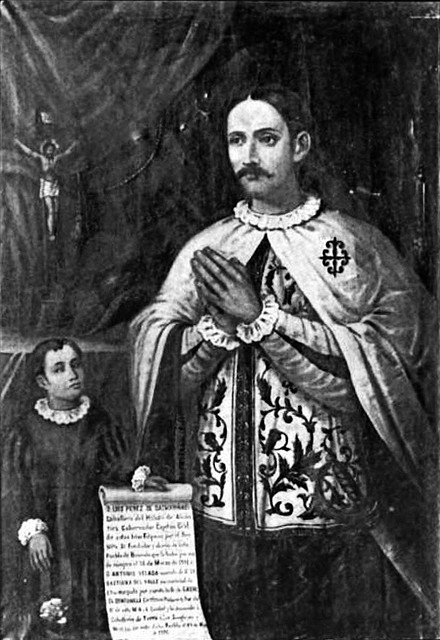
Luis Pérez Desmariñas
The Blessed Mother’s image measures 4 feet and 8 inches and is depicted carrying the Child Jesus in her right arm while holding a scepter in her left arm. Both images have a rosary slung on the right hand. From the very beginning, the faithful especially those belonging to Manila’s elite and aristocratic families have traditionally adorned both the Virgin and Child with elaborate raiment, ornate crowns and precious jewels. It now stands as the oldest ivory carving and the most resplendent example of traditional Marian iconography in the archipelagic nation.
The first Dominicans, who reached Philippine shores in 1587, established in the following year a confraternity in honor of Our Lady under the title of the Rosary. Upon receipt of the prized carved image from the benevolent Spanish governor-general, the Dominicans installed it in the aforementioned chapel withinIntramuros effectively replacing a 2-foot statue of Our Lady of the Rosary that the pioneering friars brought from Mexico to be venerated there. Thus, began a special devotion that would transcend centuries of signal graces and favors granted to the Holy Virgin’s throng of ever increasing devotees.
In a decisive series of sea battles in the middle of the 17th century, the Virgin’s intercessory powers would prove crucial in staving off the attacks of the invading Dutch fleets, a heavenly prodigy that would earn her the title of La Naval in the annals of Philippine history.
THE SPANISH-DUTCH CONFLICT REACHES THE PHILIPPINES
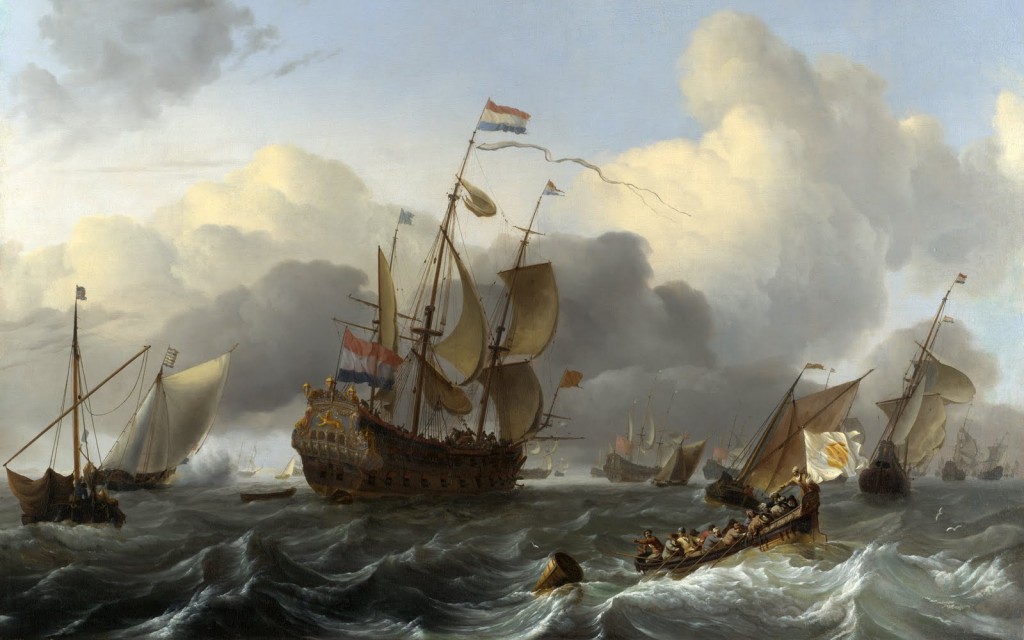
The Eendracht and a Fleet of Dutch Men-of-war, painting by Ludolf Bakhuizen.
From the late fifteenth century to mid-sixteenth century, Spain and the Dutch Netherlands locked horns in a bitter and protracted war in Europe that came to be known as the Eighty Years war or the Dutch War of Independence (1568-1648).[2]This effectively severed Dutch’s access to the lucrative spice trade which ran through the port of Lisbon in Portugal, an integral part of the Spanish empire at the time.
Henceforth, the Dutch sought to offset this setback by venturing into the Far East to seek a direct route and to monopolize commercial sea trade through piracy. The first expedition in 1595 yielded much promise with 400% returns. Another Dutch voyage set sail in 1598 that successfully returned a year later with a load of 600,000 pounds of spices and other East Indian[3] products.

A Spanish Galleon
These initial successes fueled incursions of Dutch marauders into Philippine waters and Manila Bay coastlines as they intercepted unsuspecting junks and sampans sailing forth from China and Japan.
From the early 1600’s and onwards, the better financed Dutch eventually overcame the Portuguese monopoly of the spice trade and the shift of power tilted in their favor. These early forays eventually led to the establishment of the Dutch East Indies Company in Indonesia.

The explosion of the Spanish flagship during the Battle of Gibraltar, 25 April 1607.
EARLY SEA CONFLICTS
December 14, 1600 marked the day when the Spanish and Dutch naval forces first engaged in a sea battle in Philippine territorial waters near Fortune Island off the coast of Batangas province near the mouth of Manila Bay. The Dutch flotilla of two warships, the Mauritius and Eendracht, under Admiral Oliver Van Noort faced off with the Spanish squadron of San Diego and San Bartolome under the command of an inexperienced jurist, Dr. Antonio de Morga. De Morga’s flagship San Diegosunk with heavy loss of lives while Van Noort’s altamiranta[4], Eeendracht, suffered severe damaged and was captured. The Dutch admiral limped home with his badly battered flagship and continued on to Borneo. He then set sail for the Netherlands to become the first Dutchman to circumnavigate the globe.
Three minor sea conflicts known in Philippine history as the three Battles of Playa Honda took place in 1610, 1616 and 1625 respectively, with the Spanish forces emerging victorious in all three encounters. The Dutch had dispatched these fleets in an effort to curtail the China-Manila trade and to divert the Chinese traders to their outpost (the Dutch East Indies) south of the Philippines.

The Dutch armadas also sought to upset the Manila-Acapulco galleon trade and often lay in wait to ambush the commercial ships bearing silver coins or fine silk as they entered and left the San Bernadino Strait also called the Embocadero de San Bernadino (the narrow waterway separating the islands of Luzon and Samar.)
These preliminary clashes served as a prelude to the five major Battles of La Naval in 1646.
PREVAILING CONDITIONS OF THE TIME
Recent and surrounding events prior to 1646 proved ominous to Spanish authorities and residents of Old Manila alike as well as to the rest of the country.
- The ravages of the Thirty Years’ War had taken its toll on Spain which left the Philippines scrounging for relief and aid.
- Various sea wrecks and mishaps weakened Manila’s naval capability and defense which also had debilitating economic consequences on the Manila-Acapulco galleon trade.
- The ongoing war against the Muslims of Mindanao spearheaded by Sultan Kudarat (since 1635) weighed heavy on both human and material resources.
- A Chinese uprising also known as the Sangley[5] rebellion erupted on Christmas Eve of 1639.
- The Dutch captured Malacca in 1641 and in the following year overran Spain’s fortress on the island of Formosa (present day Taiwan) north of the island of Luzon which boosted their campaign to seize King Philip II’s possessions in Asia. Now the Dutch had a strategic point to launch their coastal raids along Manila Bay and to carry out attacks on Manila. Through years of build-up, the Dutch had acquired a formidable naval presence in the region with Batavia (Jakarta) as the rallying point.
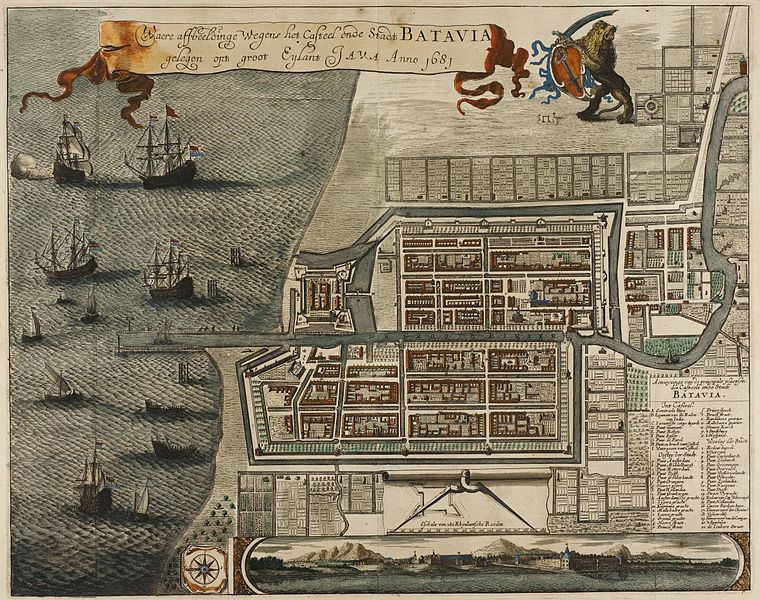
Map of the Castle and the City of Batavia, on the island of Java (now Jakarta, Indonesia)
- In the spiritual realm, Manila suffered a terrible blow when its newly installed archbishop, His Grace Don Fernando Montero de Espinosa who just arrived from Mexico on the Pacific side of Luzon Island never made it to the city when he died of hemorrhagic fever in mid-1645. Elation turned into grief. The lack of spiritual leadership further dampened the morale of the inhabitants.
- And to add insult to injury, a devastating earthquake hit the ancient city on November, 30, 1645 razing several buildings, schools and churches to the ground. The utter ruin left the city practically vulnerable and defenseless.
THE DUTCH SEIZE THE OPPORTUNITY
In spite of Dutch alliances with Muslim raiders, years of frustration to conquer Manila now came to a head. Realizing the precarious and vulnerable situation assailing Manila and the rest of the country at the time, a Dutch council in Batavia (Jakarta) resolved to gather a formidable force to wage an attack on the Philippines in 1646.
Three squadrons of 18 well equipped naval vessels comprised the powerful armada (divided into groups of 5, 7 and 6 ships respectively). Maarten Gerritz Vries headed the naval enterprise to implement a three-pronged mission: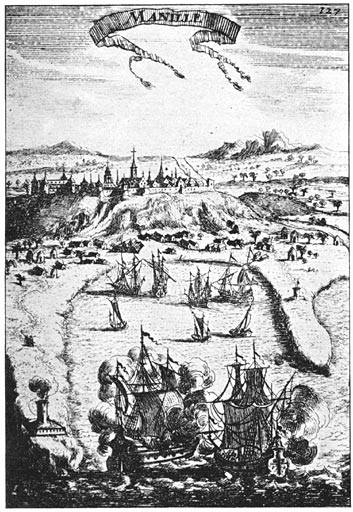
- To incite the natives against the Spaniards and to capture Chinese merchant junks and sampans along the coasts;
- To intercept the galleons from Acapulco loaded with supplies and money;
- To harass and curtail supply lines from Manila to Ternate and Makassar.[6]
Each squadron maneuvered into strategic points around the country to carry out designated tasks with the final objective of uniting into one powerful fleet outside Manila Bay to storm the city.
SOUNDING THE ALARM IN MANILA
In February, 1646, reconnaissance reports revealing the presence of Dutch ships in several areas of the Philippines spurred the Spanish government in Manila, under Governor-General Diego Fajardo Chacón, to prepare for the impending attack despite its sheer lack of a strong and able naval fleet.
In 1644, the Governor-General dispatched two aging commercial galleons to Mexico, the Encarnacíon and the Rosario, which arrived safely back the following year with much-needed supplies and goods. With no other ships on hand, the Governor-General had no option but to equip these old, heavy, decrepit and rickety galleons for battle. Some cannons were stripped from the forts of Cavite and Manila, risking their loss at sea and leaving the land without adequate artillery for defense. General Lorenzo de Orella y Ugalde took the helm as commander-in-chief and steered the Encarnacíon, the flagship or capitana. The other galleon, theRosario, served as the admiral ship or altamirana under the command of Sebastian Lopez.
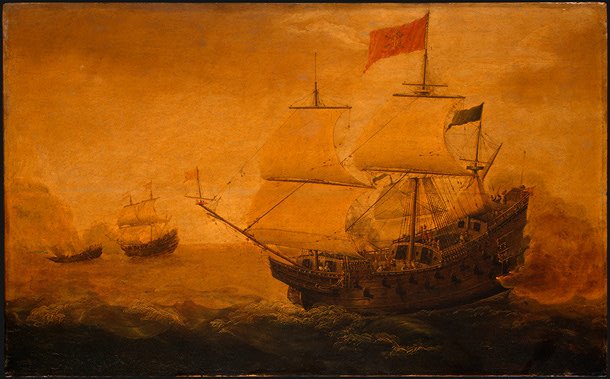
Spanish Galleon Firing its Cannon
BESEECHING HEAVEN
While preparations were underway on the natural and material plane, the need for spiritual aid and guidance were not lost on the Catholic leaders. Unbeknownst to each other, General Orella y Ugalde and Admiral Sebastian Lopez both made a vow to the Our Lady of the Rosary to walk barefoot together with their crew to her shrine at the Santo Domingo Church and to offer gratitude for the victory they hoped to obtain from her intercession. These intentions were to be revealed publicly later, prior to the second sea battle.

A Sea Battle painted by Johannes Lingelbach
Following the example of the joint Catholic forces in the great Battle of Lepanto in 1571, the naval campaign was aptly placed under the protection of the Holy Virgin bearing in mind that both ships bore the names Encarnacíon and Rosario in her honor. The Father Provincial of the Dominican friars offered to provide chaplains and ministers to both ships to which the Governor-General readily acquiesced. Four priests were called to the task with two assigned to each vessel.
The Dominican friars preached and enjoined the naval crew and officers to confess their sins and receive Holy Communion and urged them to seek the patronage of Our Lady of the Rosary; and when victory was granted, that they should celebrate a feast day in thanksgiving. The clerics also prevailed upon the soldiers the vocal recitation of the Rosary before an image of the Virgin – on their knees and in two choirs. They would fulfill this vow assiduously during the entire six month-long sea campaign especially on the days of battle.
Governor-General Fajardo Chacón himself directed that the Blessed Sacrament be exposed constantly in the royal military chapel as well as in all churches and chapels in Manila for as long as the naval forces were in conflict and pursuit of the enemy.
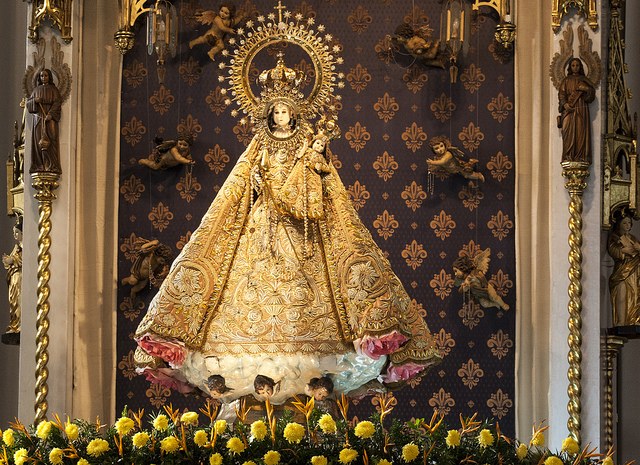
Photo of Our Lady of La Naval. By LawrenceOP
As they grew impatiently tired of waiting for the attack that never came, the Spanish-Filipino forces finally decided to actively pursue and engage the Dutch flotilla. On March 3, 1646, the Governor-General sent off the soldiers assuring them of his and the populace’s fervent prayers. Thus the fleet set sail from the port of Cavite to the coast of Mariveles, Bataan. Now, it would just be a matter of time before hostilities would commence.
THE FIVE BATTLES
First Battle
Upon reaching Mariveles, the Spanish found no trace of the Dutch. Continuing on to Bolinao in Lingayen Gulf, they finally caught sight of one enemy ship in mid-morning of March 15, 1646. At 1:00 pm, after a hot pursuit of the lone vessel, the two sides finally came within firing range of each other. The two Spanish vessels, mockingly called “two wet chickens” by the Dutch (a play of word on galeones and gallinas), confronted 4 Dutch ships and one small oar-propelled boat. After the initial exchange of salvoes, a fierce and fiery clash ensued which lasted for five hours. When the smoke cleared and the din of battle died down at 7 p.m. the enemy ships were on the retreat with the Dutch altamiranta hobbling and in danger of sinking. By a stroke of luck, the enemy slipped under the cloak of darkness and disappeared. The Filipino-Spanish forces gave chase till Cape Bojeador on the northern tip of Luzon but to no avail. With only minor damages sustained, a few wounded and no fatalities, it was no doubt a clear victory for the Catholic Spanish and native forces. The Dutch, on the other hand, suffered many casualties and two severely battered ships foundered.

After undergoing repairs in the port of Bolinao, the two Spanish ships sailed to San Bernadino Strait near the southernmost tip of Luzon upon instructions of the Governor-General. Their mission: to escort, protect and conduct safely to port theSan Luis, a commercial galleon expected to pass through the strait from Mexico on or around July 21, 1646.
Interlude
The two “wet chickens” reached the port of Ticao Island (a long strip of land between San Bernadino Strait [Embocadero de San Bernadino] and Ticao Passage, north of Masbate) in early June of 1646. There they set anchor to monitor the arrival of the San Luis and to defend it against marauding enemy ships.
Meanwhile, a second Dutch fleet that reached Philippine waters in April had been conducting raids in Jolo Island and Zamboanga on the island of Mindanao only to find out that the Spanish had already decamped due to the peace treaty signed with the Muslims just after the first battle.
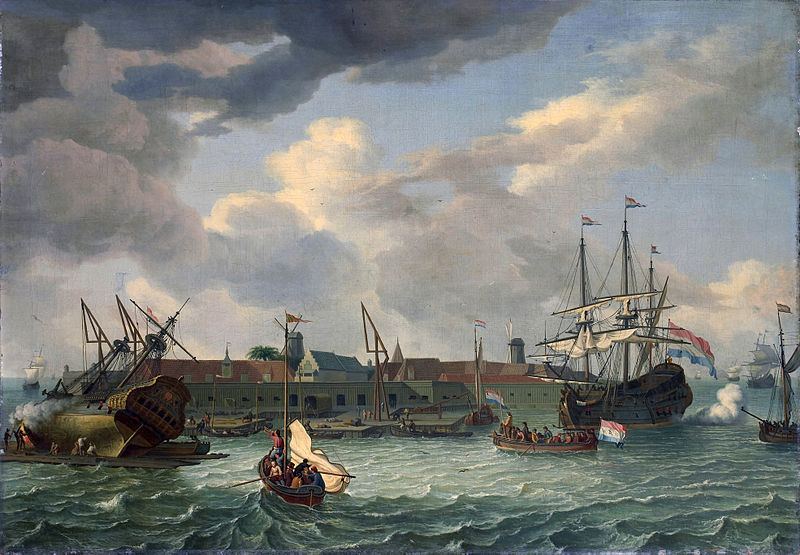
Upon receipt of orders from the Dutch headquarters in Batavia, the Dutch squadron of seven ships sailed for the Embocadero with the obvious intent of intercepting galleons arriving from Mexico. The fleet reached the area on June 22 and on the following day discovered the Encarnacíon and Rosario anchored in the port of San Jacinto which is located in a cove with a narrow entrance and exit point. The two vessels were trapped as the Dutch blocked the bottleneck passage to the harbor to form a naval blockade. To save on ammunition and powder, a war council decided to hold back and go on the offensive only when the San Luisarrived. Thus, no major clashes occurred save for some minor skirmishes where the Dutch sent intermittent launches[7] to harass the two galleons. After 31 days of standoff, the Dutch grew impatient and lifted the blockade. Thinking that theSan Luis[8] had slipped by them, the fleet headed towards the direction of Manila.
Second Battle
At the crack of dawn of July 25, the Encarnacíon and Rosario finally left the port of Ticao to confront the enemy fleet in the Embocadero. Finding the Dutch nowhere in sight, they immediately gave chase knowing that Manila lay defenseless. Finally on July 28, they caught up with the seven Dutch ships but no immediate clash ensued. Apparently, the Dutch avoided engagement in broad daylight.
True enough, on a bright moonlit evening of July 29 at seven o’clock , between the islands of Banton and Marinduque amidst calm waters, the Dutch finally approached for the kill. An intense and fiery battle commenced with fierce exchanges of cannonball and musketry fire between the adversaries. The enemy ships ganged up on the Encarnacíon but were repulsed by its intense artillery fire. The Dutch employed fireships filled with incendiary devices to no avail. They were quickly neutralized and one sent to the bottom of the sea. The battle lasted until daybreak and yet again, the Dutch found themselves on the retreat having sustained considerable damage and losses. On the run throughout the day, the Dutch refused to engage even as the Spanish commander urged them to do battle.
The flagship Encarnacíon, had no fatalities with only two wounded while the altamiranta Rosario, lost five men. The second clash would prove to be the bloodiest among the sea battles.
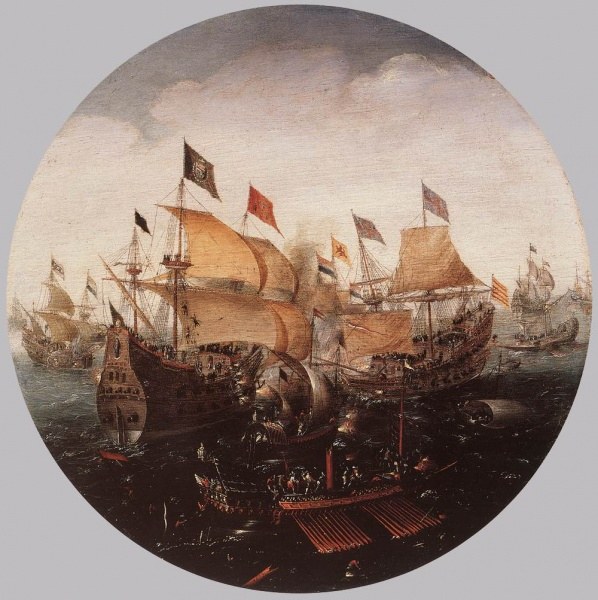
Third battle
On the next day, July 31, the feast of St. Ignatuius of Loyola, the Spanish fleet kept on the pressure on the Dutch squadron which was now reduced to six vessels and a fireship. With much persistence, the two “wet chickens” cornered the Dutch who were left with no option but to fight as they reached the waters between the islands of Mindoro and Maestre de Campo at around 2:00 p.m.
The Spanish-Filipino forces pressed on the attack sensing that their adversary was on the defensive. Since it was daytime, the odds tilted in favor of the local forces. Soon, another fierce and thunderous exchange of fire commenced. To the pleasant surprise of the Spanish-Filipino crew, their cannons and muskets worked with smooth and uncanny precision. One cannoneer attested that he fired 19 cannon shots in succession without fail, rosary on one hand and a torch on the other, while proclaiming loudly, “Viva La Virgen!”
In the heat of battle, the Dutch flagship directed its fire on the altamiranta only to be met a by a barrage of cannon balls in response. The enemy flagship suffered considerable damage that it had to withdraw quickly to avoid being sunk.
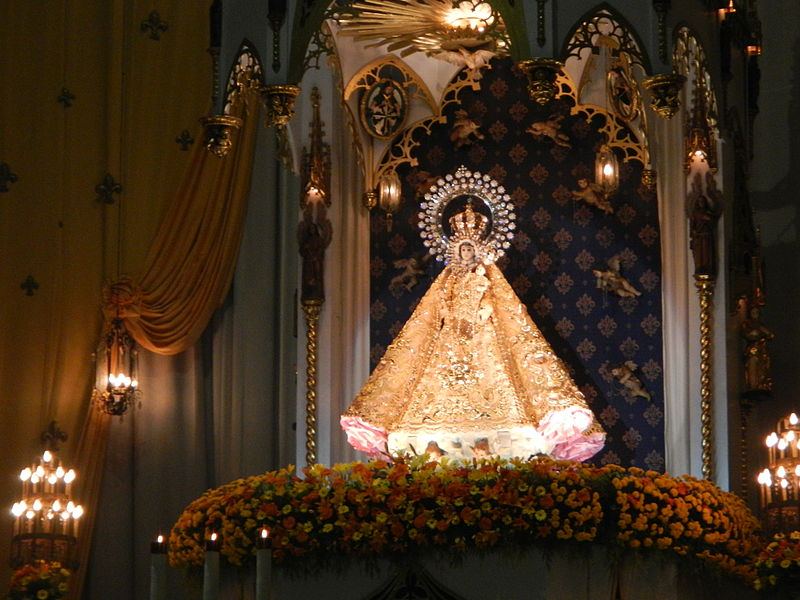
In desperation, the Dutch launched their remaining fireship hoping its load of fireworks would do major damage to the other side. Devoid of sails, it had to be escorted and dragged by launches only to end up a veritable sitting duck to furious cannonball fire. As it went down to the bottom of the sea, the Encarnacíon’s crew shouted in jubilation, “Ave Maria!” and“Viva la Fe Cristo y la Virgen Santisima del Rosario!”
The naval clash raged for the rest of the day until 6 p.m. when the routed Dutch retired and fled under cover of darkness fortuitously aided by a thunderstorm.
Having realized their miraculous victory, the officers and crew publicly declared that it was granted through the intercession and patronage of Our Lady of the Most Holy Rosary. General Orella “fell on his knees before an image of Our Lady of the Rosary and publicly gave thanks for the victory, acknowledging it as by Her hand.”
In early August, it was learned that the Dutch fleet disappeared, with two fireships sunk and the flagship badly battered. Thinking that the Dutch had enough, the Governor-General recalled the fleet to the port of Cavite for repairs and recovery.
On their return to Manila, the officers and crew were received with much acclaim by the overjoyed populace. In fulfillment of their vows, they walked barefoot, with the four Dominican chaplains, people and religious of Manila in tow, to offer gratitude and homage to Our Lady of the Most Holy Rosary in Santo Domingo Church. Little did they know that from this humble beginning would blossom a beautiful tradition of yearly processions to commemorate Our Lady’s intervention. For his valiant efforts, General Lorenzo Orella took a reward of the best encomiendas[9] in the land while the rest of the officers received a promotion in rank.
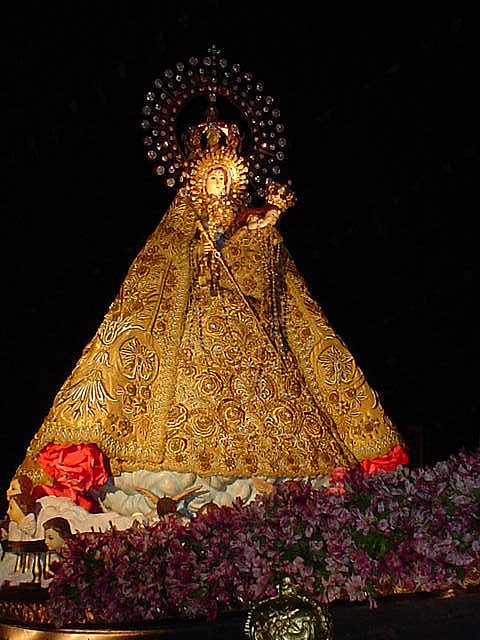
The threat renewed
By September, 1646, confident that they had stemmed the Dutch invasion, Manila authorities dispatched the newly built merchant galleon San Diego without escort at least until it reached San Bernadino Strait on its way to Mexico. Much to the surprise of its commander and crew, three Dutch ships appeared on the horizon near Fortune Island where its namesake under Antonio de Morga sunk in 1600. The enemy vessels were part of a fleet of 6 ships hoping to join the two previous Dutch flotillas which unbeknownst to them had already been soundly beaten by the local forces.
The Dutch squadron seized the opportunity to attack upon seeing the commercial ship alone and unguarded. The San Diego’s commander, General Cristobal Marquez de Valenzuela acted quickly by having five cannons brought on deck. Fortunately, they were enough to help thwart the surprise attack but not without sustaining some casualties. The ship then retired to Mariveles for safety.
When Governor-General Fajardo Chacón received news of the skirmish, he immediately reorganized the Spanish armada by adding the now armed San Diegoto the fleet. Don Sebastian Lopez, the second in command in the previous three battles, took over the helm of the flagship Encarnacíon now that General de Orella had retired from service. Don Agustin de Cepeda, the former sergeant-at-arms, ascended to the admiralship of the altamiranta Rosario. A galley of 100 sailors with an escort of 4 brigantines reinforced the fleet.
The same spiritual preparations and solemn vows were made as with the previous campaign. Two Dominicans retained their chaplaincy of the flagship while two Franciscans now tended to the altamiranta. An Augustinian priest took charge of the extra galley.
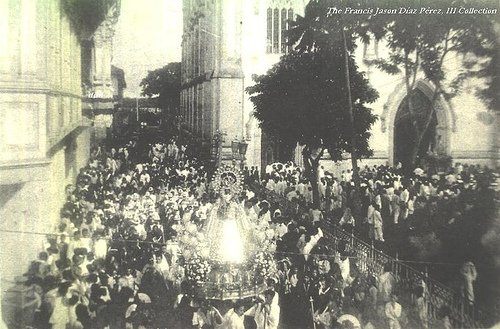
Fourth Battle
By September 15, the armada was ready, willing and able to set sail to meet the Dutch challenge once again. The search for the enemy in the vicinity of Fortune Island proved unsuccessful. With patience and perseverance they finally caught sight of the adversary’s flotilla off the coast of Mindoro Island near Calavite point. At 4:00 p.m., while struggling against the wind, the Spanish flagship nevertheless opened fire to signal its challenge. Unable to close the gap, both sides fought for five hours at a distance using long range artillery.
At around 9:00 p.m., the Rosario, inadvertently it seemed, drifted into enemy territory and was surrounded by the Dutch ships. There was nothing the Spanish flagship could do to come to the aid of the altamiranta under cover of darkness. As expected, a fiery and intense exchange ensued which lasted a good four hours. At one point, the guns of the altamiranta fell silent, which emboldened the Dutch ships to draw near for the kill. Little did they know that it was just a ruse. As soon as the Dutch vessels came within firing range, the altamiranta, on orders of Admiral Cepeda, set their cannons ablaze causing considerable damage to the enemy which hastily retreated.
At daybreak, the Spanish flagship’s crew could now see the altamiranta and finally came to its rescue. But by then, the enemy had already taken flight after receiving another terrible beating.
The Fifth Battle
The San Diego was beset by structural defects that needed correction thus its journey to Mexico had to be aborted by a council convoked by General Lopez. It laid anchor at Mariveles under the watch of the “two wet chickens.” Unfortunately, the Rosario drifted away due to strong currents which it could not overcome thus separating it from the rest of the Spanish fleet.
Meanwhile the three Dutch ships, which according to records were huge and armed to the teeth, reemerged on October 4, 1646, the feast of St. Francis, apparently sensing their adversary’s predicament. Thinking they had the upper hand, the Dutch decided to press the attack and approach the Spanish flagship.
The Encarnacíon’s commander chose to bide his time and wait for the enemy to come nearer since it would be too much of a gamble to leave the San Diego alone. At a given moment, the flagship’s sails unfurled and unleashed its cannons on the approaching enemy ships. Thus began another tumultuous and relentless clash of firepower that lasted four hours. Like the Rosario in the previous battle, the Encarnacíon bucked all odds as it engaged the three Dutch warships singlehandedly while inflicting heavy casualties on the enemy which withdrew to a quick retreat.
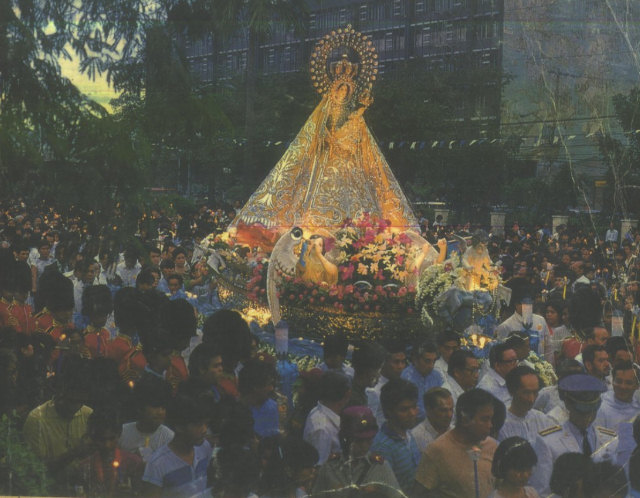
Much to the chagrin of the fleeing Dutch, the wind died out and their progress stalled. Admiral Francisco de Esteyvar seizing the window of opportunity ably launched a daring attack from his oar-driven galley which was now being propelled under the cadence of the Hail Mary. With just a single cannon on the prow and some culverins, he picked on the nearest Dutch ship which suffered so much damage it almost sunk. Some enemy crew jumped ship in panic but luckily the wind returned which saved the day for them as the ships disappeared into the night even as the Encarnacíon and galley followed in hot pursuit.
At battle’s end, the intact Spanish galley sustained no casualty. However, the flagship suffered four fatalities but with minimal damage. Once again, the Spanish-Filipino forces gained another tremendous victory.
A TRADITION BEGINS AND FLOURISHES
Upon their triumphant return to Manila, the officers and crew fulfilled once more their solemn vow and promise of walking barefoot to the shrine of Our Lady of the Most Holy Rosary in Santo Domingo Church.
On January 20, 1647, a solemn procession, Mass, and a parade of the Spanish squadron celebrated the decisive victory. Soon thereafter, the City of Manila convened a council which pledged to solemnly commemorate the naval victories annually.
And to this day, the Feast of Our Lady of the Most Holy Rosary of La Naval de Manila is celebrated yearly with much pomp and ceremony on the second Sunday of October. It is a fitting tribute to Our Lady as the Patroness of Christian navies, a patronage which traces its roots to the resounding triumph of the Catholic forces against the Ottoman Turks in the Battle of Lepanto in 1571 where Pope St. Pius V, also a Dominican, entrusted the Catholic fleet to the protection of Our Lady of the Rosary. In thanksgiving, the holy pontiff, added the Feast of the Holy Rosary to the Church calendar and the invocation Auxilium Christianorum to the litany of Our Lady, in humble yet fitting acknowledgment of her powerful intercession.
NOTHING BUT MIRACULOUS
Noting the extraordinary circumstances that led to the victory, the Archdiocese of Manila conducted an ecclesiastical inquiry at the behest of the Procurator General of the Dominican fathers, Father Friar Diego Rodrigues, O.P.
The most striking occurrences scrutinized were as follows:
- The Spanish-Filipino forces lost only 15 crew members;
- The fleet comprised mainly of two aging, rundown merchant galleons;
- The troops prayed the Rosary faithfully to ask for the Holy Virgin to intercede and to grant them the victory.
After a thorough examination of witnesses and pertinent events “the Venerable Dean and Chapter of the Archdiocese of Manila declared as miraculous the victories obtained by the defenders of religion in the Philippines against the Dutch, in the year 1646.”
On April, 9, 1652, the official declaration states:
“That we should declare and we do declare that the five battles expressed in the testimonies, which the said two galleons, under Catholic arms, won against the Dutch enemies, were and should be upheld as miraculous, and that they have been granted by the Sovereign Majesty of God by means of and through the intercession of the Most Holy Virgin Our Lady and Her devotion, the Holy Rosary.”
Author’s notes:
This article was pieced together mainly from two sources:
- Cortes, Regino, O.P., Ph.L., S.Th.L., S.S.L. The Story of La Naval. Quezon City: 537 Quezon Avenue, Santo Domingo Convent.
- “Battles of La Naval.” Wikepedia, The Free Encyclopedia. Wikimedia Foundation, Inc.. 2 September 2012. Web. 5 September 2012.http://en.wikipedia.org/wiki/Battles_of_La_Naval_de_Manila
Other references:
- “The Story of La Naval.” La Naval De Manila Online. 27 November 2007. Web 6 September 2012.
- “The Spice Trade.” Wikepedia, The Free Encyclopedia. Wikimedia Foundation, Inc… 17 July 2012. Web. 2 September 2012.
- Joaquin, Nick. “Ikon, Friar and Conquistador.” Filipino eScribbles; random jottings about everything Philippine. 2 March 2010. Web. 3 September 2012.
- “‘Remembrance of La Naval De Manila’ at the Santo Domingo Church. 24 September 2006. Web. 31 August 2012.
- Aquino, Leslie Ann G. “Catholics Celebrate Feast of La Naval.” mb.com.ph.Manila Bulletin Publishing Corporation. 9 October 2010. Web. 1 September 2012.
- Hellingman, Jeroen. “History of the Philippine Islands.” Ebook. pp.104-107.Wattpad. Web. 2 September 2012.
- Crossley, John Newsome. Hernando de los Ríos Coronel and the Spanish Philippines in the Golden Age. Burlington, VT: Ashgate Publishing Company, 1988. Google Books. Web. 1 September 2012.
- Jernegan, Prescott Ford. A Short History of the Philippines: For use in Philippine Schools. New York: D. Appleton and Company, 1905. Google Books.Web. 30 August 2012.
- Ocampo, Ambeth. “The Christmas Eve uprising of 1639.” Philippine Daily Inquirer. 12 December 2008. Web. 2 September 2012.
- Lach, Donal F., Van Cley, Edwin J. Asia in the Making of Europe, Volume III: A Century of Advance. Chicago: The University of Chicago Press, 1993. Google Books. Web. 29 August 2012.
- “Dutch East Indies.” Wikepedia, The Free Encyclopedia. Wikimedia Foundation, Inc.. 5 September 2012. Web. 6 September 2012.
- 12.“Eighty Years’ War.” Wikepedia, The Free Encyclopedia. Wikimedia Foundation, Inc.. 27 August 2012. Web. 27 August 2012.
- 13. Photo credit: La Naval Procession
www.flickr.com/photos/francisjasondiazperez/3986743490
[1] A canonical coronation is a Papal act, decreed through a papal bull, by which the Roman Catholic Church officially honors an image of the Virgin Mary venerated under a specific invocation in a particular region or locality. In his encyclical Ad Caeli Reginam (October 11, 1954), Pope Pius XII declares, “The Roman Pontiffs, favoring such types of popular devotion, have often crowned, either in their own persons, or through representatives, images of the Virgin Mother of God which were already outstanding by reason of public veneration.”
[2] This conflict between Catholic Spain and the Protestant Netherlands freed the latter from Spain, resulting in the separation of the Southern part of the Netherlands (Flanders) from the Northern part. It led to the establishment of the Republic of the Seven United Provinces of the Netherlands or the Dutch Republic.
[3]The Indies or East Indies (or East India) generally refers to a broad area of lands of South and Southeast Asia, covering all of present India, Pakistan, Bangladesh, Myanmar, Nepal, Bhutan, Sri Lanka, the Maldives, and stretching through Thailand, Cambodia, Laos, Vietnam, Brunei, Singapore, the Philippines, East Timor, Malaysia and most of Indonesia.
[4]Altamiranta – a Spanish term referring to the admiral ship usually led by the second in command. The flagship is called the Capitana.
[5] From the Spanish Sangleyes, the term for a Manila Chinese.
[6]Since 1612, Manila governed and protected militarily the Moluccas Islands.
[7] A heavy open or half-decked boat propelled by oars .
[8] It was later discovered that the San Luis sunk off the coast of Cagayan.
[9]A sytem, instituted in 1503, under which a Spanish soldier or colonist was granted a tract of land or a village together with its native inhabitants.





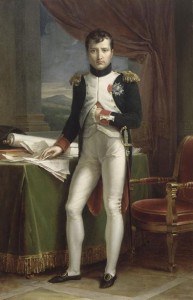


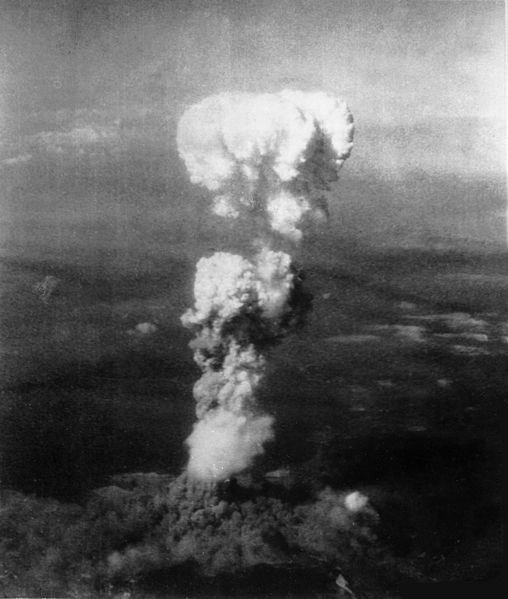
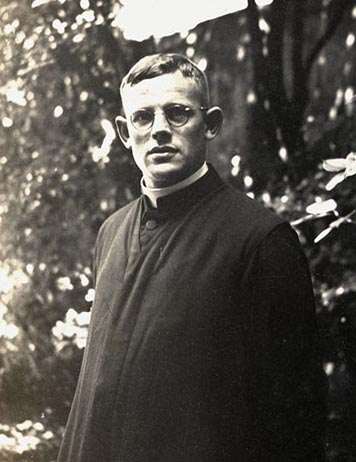


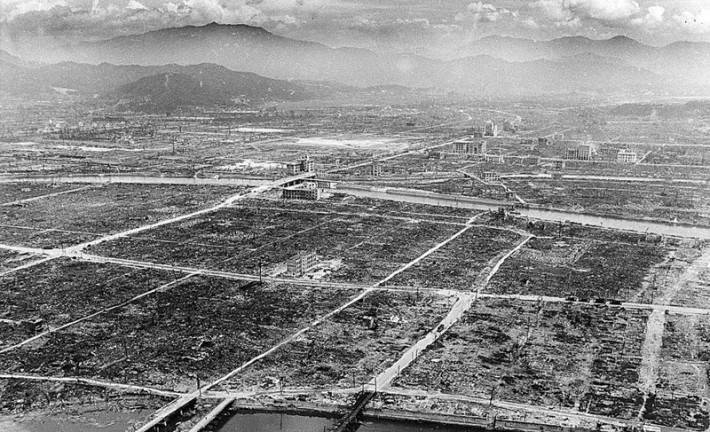

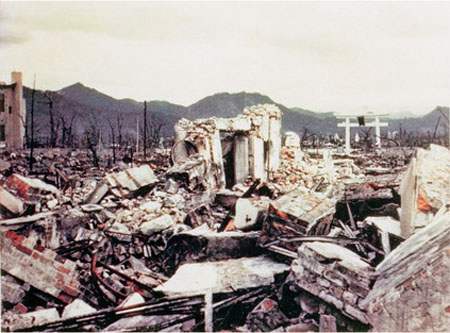

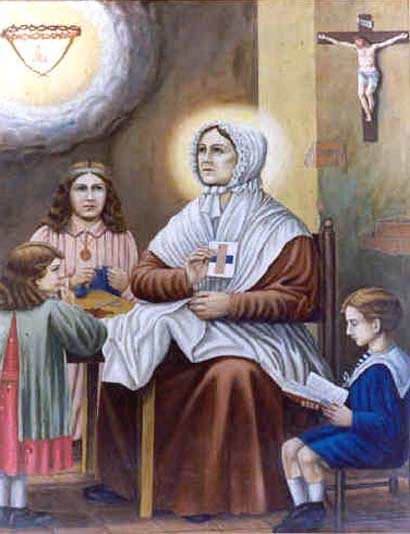
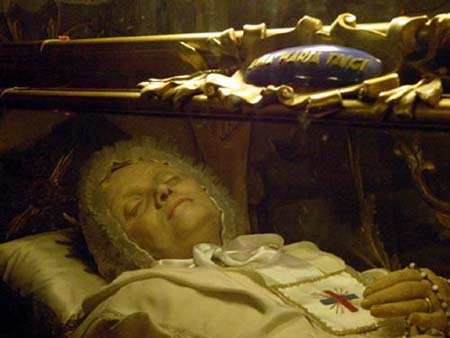

 “ Return to Order provides an interesting analysis of how the United States has departed from the spiritual, cultural, and economic precepts that supported the founding and the early history of our republic. It also sets forth valuable recommendations for restoring our society to its foundation of ordered liberty and traditional values.”
“ Return to Order provides an interesting analysis of how the United States has departed from the spiritual, cultural, and economic precepts that supported the founding and the early history of our republic. It also sets forth valuable recommendations for restoring our society to its foundation of ordered liberty and traditional values.” “If our nation ever needed to return to traditional values, it is now. Each of our problems has at its roots a moral solution found in the tenets of the Christian tradition. Return to Order does a great job of highlighting the source and solution to our impending demise.”
“If our nation ever needed to return to traditional values, it is now. Each of our problems has at its roots a moral solution found in the tenets of the Christian tradition. Return to Order does a great job of highlighting the source and solution to our impending demise.” “Return to Order offers a synthesis of Catholicism’s invaluable contribution to the building of a humane and ordered society in which the human person can flourish. When culture, economy, polity, and religion form an ethical whole, children, families, businesses, religious communities and individuals find their fulfillment through making their contribution to the common good. Return to Order shows us a clear way out of the current cultural crisis which besets the great human project.”
“Return to Order offers a synthesis of Catholicism’s invaluable contribution to the building of a humane and ordered society in which the human person can flourish. When culture, economy, polity, and religion form an ethical whole, children, families, businesses, religious communities and individuals find their fulfillment through making their contribution to the common good. Return to Order shows us a clear way out of the current cultural crisis which besets the great human project.”
 “In this very well-documented and argued work, John Horvat ingeniously demonstrates how the four cardinal virtues are the basis of a free and prosperous society.”
“In this very well-documented and argued work, John Horvat ingeniously demonstrates how the four cardinal virtues are the basis of a free and prosperous society.” “An erudite cultural sculptor, Horvat chisels away materialism’s false promises and points toward God as the source of the higher revelation that makes beauty, heroism, nobility, sacrifice and true vocation discoverable and meaningful.”
“An erudite cultural sculptor, Horvat chisels away materialism’s false promises and points toward God as the source of the higher revelation that makes beauty, heroism, nobility, sacrifice and true vocation discoverable and meaningful.” “The central theme of frenetic intemperance is original, interesting, and compelling. The diagnosis of contemporary social maladies must focus on moral failings, and Return to Order rightly does so. Its insightful thesis deserves wide circulation and consideration."
“The central theme of frenetic intemperance is original, interesting, and compelling. The diagnosis of contemporary social maladies must focus on moral failings, and Return to Order rightly does so. Its insightful thesis deserves wide circulation and consideration."















